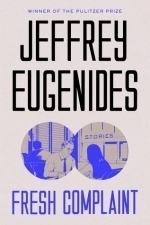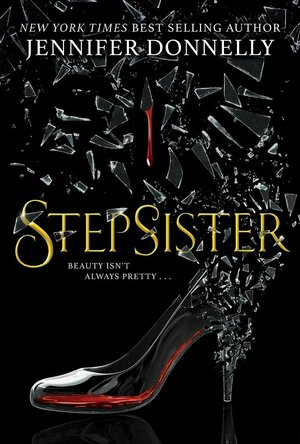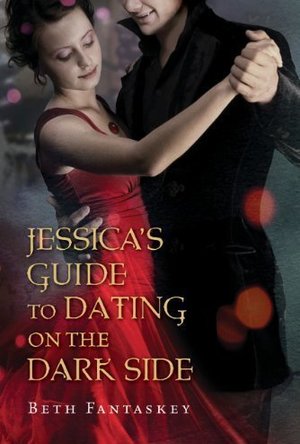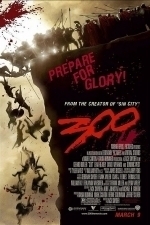Kristy H (1252 KP) rated Fresh Complaint in Books
Jan 10, 2018
I often skip story collections, as I tend to feel a loss with them, as if the tale is unfinished, and I just want more details about each character and their motivations and end-state. I picked up FRESH COMPLAINT based solely on my love for Eugenides (Middlesex is an all-time favorite). I won't lie: I still felt that same unfinished feeling at the end of most of the stories. Clearly I just am meant more for long-form fiction. I also hadn't realized when I picked up the book that most of the stories were previously published, but luckily I am not usually reading The New Yorker and such, so I hadn't come across any of these previously.
One of the most exciting discoveries for me was, upon completing "Baster," confirming that it was indeed the premise for the silly film "The Switch" with Jason Bateman and Jennifer Aniston that is an incredibly guilty pleasure of mine. The story differs from the film, but you can clearly see how it's the base, and it's quite enjoyable.
Another favorite of mine was "Fresh Complaint," the final story in the collection, and clearly where it gets its title. We meet a young woman, Prakrtri, who is struggling with the fact that her family is trying to arrange a marriage for her, and a college professor who is traveling for work. How their paths cross is quite interesting. It's detailed, touching, and yet disturbing.
My other favorite was "Great Experiment" featuring an editor, Kendall, in his mid-thirties. He's comparing himself (unfavorably) to his peers, as he struggles financially in his job and resentfully watches his wealthy boss live well while not even providing Kendall health insurance. The story takes an interesting turn, and, as with much of Eugenides work, seems to have a greater message for us.
Overall, I didn't enjoy this as much as an Eugenides novel, because there just isn't the time to fall for his nuanced characters. I still enjoyed many of the stories and realize I probably gravitated toward "Fresh Complaint" and "Great Experiment" because they were some of the longer tales in the collection. If you like Eugenides, you may want to pick up this collection (provided you haven't already read the stories elsewhere). If you haven't read him in any form, go find Middlesex instead. 3.5 stars.

Brian Tracy's, Eat That Frog! Daily Goals, Motivation, Productivity, Effectiveness & Focus!
Productivity and Business
App
Featured by Apple in iTunes Store "New & Noteworthy" Section! --Checkout the new, "Habits 2 Goals"...
Lottie disney bookworm (1056 KP) rated Stepsister in Books
Aug 16, 2019
Judging purely by the title of the book: the cynical side of me expected this to be a retelling of the traditional fairy tale from the viewpoint of the “ugly stepsisters”. Perhaps with a remorseful twist and a concluding reconciliation. I could not have been more wrong.
This is possibly the first time I should have judged a book by its cover: the iconic glass slipper casting fragmented shards across the jacket should have certainly forewarned me that this will not be just another Cinderella story.
Unlike the twisted tales and the villain series, Step Sister is, as far as I know, not connected to the Disney enterprise at all. This makes it an edgier read by far but also allows the novel to lean as far away from the traditional fairy tale as it dares: smashing just a couple of stereotypes along the way.
Oh, and just a quick point: the novel opens on Isabelle and Octavia disfiguring their own feet, at the command of their mother, with the aim to fit into the glass slipper and marry the Prince. See what I mean- edgy right?
Stepsister is told from the viewpoint of Isabelle: a headstrong girl with an ambitious mother, an intelligent sister Octavia and a kind, sweet sister, Ella. Isabelle is a disappointment to her mother: a plain girl who prefers riding and fencing to corsets and suitors. A number of flashbacks to the girls’ childhood also suggests that Isabelle, Octavia and Ella were once very close, leading the reader to wonder how the relationship became the poisonous one we are so familiar with.
Unsurprisingly, their Maman’s plan to mutilate her way to the palace does not succeed and Ella takes her rightful place by the Prince’s side, claiming her ‘happily ever after’. But what is to become of the family she leaves behind? Maimed and outcast, Isabelle and Octavia struggle to carry on once their actions are brought to light and they are promptly labelled the “ugly stepsisters” by all around them.
Desolate and lost, Isabelle mistakenly believes that her life would improve if she were more attractive and makes a wish to the fairy queen Tanaquill, who promises to grant her desire when Isabelle finds the three missing parts of her heart.
Thus, begins Isabelle’s mission to reclaim her heart and turn her life around. The stepsister’s road of discovery is a bumpy one however, and is not made any easier by an old crone named Fate and a young man named Chance, both of whom seem to have an unhealthy obsession with her progress and a strange, almost friendly rivalry over the possession of Isabelle’s life map.
Jennifer Donnelly introduces us to a number of characters throughout Isabelle’s journey, all of whom are exquisite: Chance is an eccentric debonair with an entourage that may have just stepped out of The Greatest Showman; Octavia is every nerdy, sarcastic girl’s dream and even Fate is strangely likeable. It is truly impressive how Donnelly can make us feel like we know these people within the space of 470 pages.
I was also impressed with how different Jennifer Donnelly’s characters are from everything I have read before. Even Tanaquill is not the fairy godmother we all know and love. She isn’t even the slightly bonkers Helena Bonham-Carter version! There isn’t a bibbidi bobbidi boo in sight for this talon-fingered shapeshifter and she certainly does not grant wishes easily.
As a result, the reader does not quite trust the fairy queen: there is always an aspect of her that seems evil. Alas, this is another stroke of genius by Donnelly: the fairy queen doesn’t look like Tinkerbell or the Blue Fairy and so we don’t trust her- even when she is helping Isabelle and why is that? Because of her appearance? Well that makes us just as bad as those who persecute Isabelle!
Ella features very little in the novel. This is not wholly unexpected: it is not her story after all. She is frequently referred to and heavily present in Isabelle’s evolution but, out of all the characters, we know Ella the least. This is not to say that Donnelly presents Ella as a 2D character in order to prevent us from preferring her to our feistier protagonist: in fact, Ella slowly reveals a darker side to her own tale. Simply put, she does not have the depth and human rawness that Isabelle has. Isabelle appeals to the insecure teenager in us all: never believing that she is good enough, focusing on her flaws and judging herself based on the opinions of others.
When Isabelle finally finds the pieces of her heart and has to literally fight to achieve her happy ending, she automatically looks to one of the male characters to lead. After all, it has always been instilled into her that she is “just a girl”. However, Chance and his entourage have educated Isabelle as to the potential of her sex and it is through this inspiration that Isabelle and the reader realise that the answer has been there all along: the answer is Isabelle. All the childhood flashbacks of riding and fighting have been breadcrumbs for the reader: Isabelle is a warrior- her life is not mapped out by Fate or Chance anymore; she can decide her own path.
Step Sister holds up a gigantic mirror to the way we judge beauty and shows us what it really means to be a girl. Jennifer Donnelly proves that being strong, brave and, most importantly, true to yourself is what makes you beautiful. In fact, it is not until Isabelle accepts herself that she is described as beautiful and, by standing up for what she believes in, everyone achieves their own happy endings. As a mum of two young boys I really appreciated how Octavia’s love of science and math and Felix’s creativity and love of art directly contrasted with Maman’s old-fashioned desire to “marry off” her daughters. This story is no fairy tale: it is real, it is edgy and it is telling all generations that life is what you make it.
Hazel (1853 KP) rated The Joyce Girl in Books
Dec 14, 2018
Winner of the Impress Prize for New Writers 2015, Annabel Abbs creates a fantastic work of historical fiction based upon the life of Lucia Joyce. Although the titular character may be unheard of within the general public, her father will be known amongst the majority of readers. James Joyce, the eccentric author of<i> Ulysses</i> and <i>Finnegan’s Wake</i>, travelled around Europe with his family until settling in Avant-garde Paris, 1928. His daughter, Lucia, an ambitious, talented dancer describes the unconventional life as a child of Mr. Joyce, its ups and downs, and inevitable ruinous breakdown.
<i>The Joyce Girl</i> begins in Küsnacht, Zurich where Lucia is receiving treatment from Dr. Carl Jung – another well-known name; this novel is full of them. Struggling to come to terms with her current mental ill health and supposed repressed memories, Jung encourages Lucia to write her memoirs in order to learn of the events that led to this current predicament. Starting from 1928, aged 21, Lucia describes her life to Jung and the reader in brutally honest detail.
The unusual Irish family went through various successes and traumas in the intervening years, creating a humorous and emotional story. Lucia’s brother, Giorgio, caused the family enough problems without adding in the devastating heartache Lucia suffers from men who do not reciprocate her love. One of these lovers is the famous Samuel Beckett (<i>Waiting for Godot</i>, 1952), the first man Lucia falls for. It is fascinating to learn of the multiple connections these notable names had with each other. Although in retrospect it makes sense that the literary and artistic crowds would stick together.
From Lucia’s memoirs Jung formulates that the Joyce parents were extremely controlling, not giving Lucia the opportunity to live her own life – particularly within her dancing career. However, Jung still maintains that Lucia experienced emotional trauma and is insistent on retrieving those memories. What he eventually discovers will shock and possibly sicken the reader.
Through enormous amount of research, Annabel Abbs has put together a likely account of the Joyce family, particularly Lucia’s life. Using existing biographies, original letters and professional opinion, Abbs devises a logical narrative for the unfortunate dancer. Drawing upon knowledge of other literary greats and artists of the era, <i>The Joyce Girl</i> can be easily believed to be a true account, although doubtlessly some scenes must be based upon imagination.
<i>The Joyce Girl</i> will attract historical and romantic novel enthusiasts, providing an enjoyable, thought capturing story, as well as an opportunity to learn. Whether you are aware of James Joyce’s works, or even Lucia herself, <i>The Joyce Girl</i> is bound to capture your attention and draw your mind into the European life during the early 1930s. Although only her debut novel, Annabel Abbs comes highly recommended and it will be interesting to see what direction she has decided to take in her shortly expected second novel.
Lee (2222 KP) rated Crazy Rich Asians (2018) in Movies
Sep 3, 2018
Now, for this movie I think the trailer nailed it in terms of what you see is what you're going to get. And in my opinion, I'd say how you feel after seeing the trailer for this movie is a pretty good gauge for how you'll feel about the movie as a whole. Personally, I watched the trailer and I didn't think it looked that great. The story looked mildly interesting, there were some funny characters and some potentially great performances, but there was nothing in the trailer that grabbed me and stuck with me. And that's exactly how I felt about the movie after I'd seen it.
The story centres around Rachel and Nick, both living in New York and having been dating for a while. Nick is due to head home to Singapore for his best friends wedding and has asked Rachel to join him. The opening scene of the movie, featuring Nick as a young child, gives us some insight into how much wealth and power his family possess. We also see how an innocent photo of Nick and Rachel talking in a bar quickly hits Singapore social media, setting thousands of tongues wagging and giving us a pretty good idea just how big a deal Nick and his family are over there. And how much of a talking point it is that Nick is dating a girl raised in America, rather than Asia. It's only when they land in Singapore that Rachel realises the full extent of what she's let herself in for.
Nick is part of a big, rich family, with each family member having their own set of problems and insecurities to deal with. I actually had trouble keeping track of who's who for a while, but one thing this movie does do is allow sufficient time for all family members to be explored and for some particularly strong performances to blossom. Nicks mother Eleanor (Michelle Yeoh) is the one that Rachel is out to impress though, and although she remains polite at all times, it's clear that she doesn't approve. I thought this was going to be a variation of the boy and girl hate each other at first theme that I spoke about earlier, and while it kind of is in a way, it doesn't make for such a fun, easy ride like standard rom coms do.
For me, those strong performances I spoke about came from Gemma Chan as a millionaire cousin with an insecure cheating husband, and Constance Wu as Rachel. Michelle Yeoh is somebody we're probably a bit more familiar with, and she was also outstanding as Nicks mother Eleanor. There are plenty of characters providing comedy relief and bringing the 'crazy' to the films title. Most notably Awkwafina as Rachel’s best friend and Ken Jeong, who seemed slightly subdued for once.
Overall I didn't not enjoy this movie, but then I didn't enjoy it as much as I'd hoped I would either. I laughed, I was entertained, but I felt the movie dragged and stumbled at times, and didn't really elevate itself above just a standard rom com for me.
Haley Mathiot (9 KP) rated Jessica's Guide to Dating on the Dark Side (Jessica, #1) in Books
Apr 27, 2018
Genre: YA Paranormal romance
ISBN: 9780547259406
Pub date: January 18th 2010 by Graphia (first published in hardback on February 1st 2009)
Rating: 5
Jessica was sure she was just your average teenager… until an ultra-hot European foreign exchange student shows up at school, stalks her, and then follows her home, insisting that they are both vampire royalty and must be married when she turns eighteen to ensure peace between their families… and Jessica is sure that Lucius, no matter how attractive, is absolutely insane. She manages to free herself of his grip… and then realizes that he’s all she ever wanted in the first place. But getting him back before he destroys her –or himself—will be quite a challenge. But Jessica is up to it. She has to be.
I absolutely loved Jessica’s Guide. It was funny, romantic, and entertaining the whole way through. I don’t know why I put off reading it so long.
The plot had great pacing, great twists, and great conflict. At one point I was tempted to flip to the end of the book just to make sure it all worked out at the end… because I wasn’t sure I could handle it if it didn’t.
I loved how Jessica’s and Lucius’s relationship wasn’t perfect. I saw this in Fantaskey’s other novel, Jekel Loves Hyde. Like Jill and Tristen, Jessica and Lucius certainly had their ups and downs… may I say more of the latter than the first. I dispise happyland syndrome in romances… and was pleased to find none whatsoever in Jessica’s Guide. Their romance was destiny and fate, the only question was how they’d get there in the end. And it was quite a rollercoaster. Their love was based on character more than actions, something that is sometimes hard to write well, and many authors fail miserably, but Fantaskey did a great job. For both Jessica and Lucius, there can never be anyone else.
The characters were great. I officially adore Lucius… passionate and mysterious and infuriating…we need more heroes like him… and Jessica was the kind of girl who would work hard for what she wanted, and sacrifice anything. I think we need more heroines like her, too! Jessica’s parents were both annoying and funny… I especially loved her mom.
The writing was fluid and descriptive, and easy to read. I demolished this one in about four hours.
Heart-pounding plot, characters to die for, and an epic romance, this one begs many re-reads.
Content/recommendation: some language, no sex. Ages 14+. This one is a perfect summer-read… or anytime read, really.

cooking-china
Food & Drink and Lifestyle
App
Hello fellow Chinese food enthusiasts.. Learning to cook Chinese food on your iPhone and iPad is...

EASA ATPL Theory Exam Prep
Education and Lifestyle
App
Our GroundSchool EASA ATPL (Airline Transport Pilot License) Airplane theory exam preparation app is...
Darren (1599 KP) rated 300 (2007) in Movies
Jun 20, 2019
Leonidas selects 300 warriors who have sons to carry on their names to go and fight leaving Sparta behind. One the way to the battle Leonidas and his men learn what the Persians are capable off as they prepare for the battle. We follow King Leonidas and his 300 as they plough through the Persian army defying all of the odds, while another battle for power rages on back at Sparta.
300 shows how determined one group of people were to protect their own land, sure we have comic book style which helps the film enter the fantasy side. It doesn’t have the most original screen story but this is clearly made for the action. We do see how the warriors of Sparta would have been the better in battle even if the actual battle turned into something very fantasy based. Just remember you won’t need to be thinking too much through this film, just relax and enjoy. (7/10)
Actor Review
Gerard Butler: King Leonidas fearless warrior who leads his army of 300 into battle against the Persians against all odds. He goes against all the gods and wishes of their oracle to battle for his people. Gerard gives a good performance showing how he was going to be a lead actor. (8/10)
leonidas
Lena Headey: Queen Gorgo who is left to rule Sparta while the King goes into battle. She has to deal with Theron who stays back might not be as loyal as first thought. Lena gives a good performance and shows how she was always going to be playing a Queen. (7/10)
lena
Dominic West: Theron Spartan who stays behind and tries to use his power in the city to gain power over the people while Leonidas is battling for their freedom. Dominic gives a solid performance as the scheming villain. (6/10)
dom
David Wenham: Dilios warrior who is also the story telling, he provides narration for the story and fills us in on Leonidas’ past. David gives a good performance as the story teller but also warrior who fights for Sparta. (6/10)
david
Michael Fassbender: Stelios one of the fearless warriors who has never faced a real challenge and hopes to find one in this battle. Michael gives a good performance as the greatest warrior of the army in what was his debut role. (7/10)
stelios
Support Cast: 300 supporting cast is filled with warriors on both sides of the fight, they all have their moments in the battle.
Director Review: Zack Snyder – Zack showed why he is such a popular director with his newer style of directing which is both unique and entertaining. (8/10)
Action: 300 has plenty of fights but what did you expect from this kind of war film. (9/10)
Fantasy: 300 uses fantasy for its battles showing how different types of warriors could be looked and the legend created by fear. (8/10)
War: 300 shows of the great battles between the Persians and the Spartans. (10/10)
Settings: 300 creates the settings to look very authentic looking scenery for the battle scenes. (9/10)
Special Effects: 300 uses great effects for the fights and to create the different style of fighters. (9/10)
Suggestion: 300 is one for the action fans to enjoy, it has plenty of fighting but not much in the way of thinking needed. (Action Fans Watch)
Best Part: Stelios Now.
Worst Part: Lots of shouting from Leonidas.
Action Scene Of The Film: The first battle.
Kill Of The Film: Monster creature man vs Leonidas.
Favourite Quote: King Leonidas ‘This is Sparta!’
Believability: No (0/10)
Chances of Tears: No (0/10)
Chances of Sequel: Has a sequel.
Post Credits Scene: No
Oscar Chances: No
Box Office: $456 Million
Budget: $65 Million
Runtime: 1 Hour 57 Minutes
Tagline: Spartans, prepare for glory!
Overall: THIS IS ‘JUST’ GOOD!
https://moviesreview101.com/2015/05/16/300-2006/
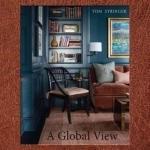
Tom Stringer: A Global View
Book
Tom Stringer is a prolific and highly regarded United States based interior designer whose work...
